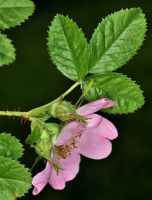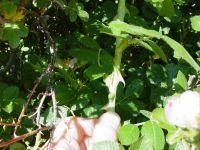Distribution: Occurring on both sides of the Cascades crest in Washington, though more common west of the crest; southern British Columbia to California, east to Idaho, Montana, Wyoming, and Colorado, further east from the Great Plains to the Atlantic Coast.
Habitat: Roadsides, thickets, shorelines, pastures, and other disturbed, open areas.
Flowers: June-July
Origin: Introduced Eurasia and northern Africa
Growth Duration: Perennial
Conservation Status: Not of concern
Pollination: Bumblebees, bees, beetles
Coarse shrub 1-2 m. tall, with well-developed, flattened, unequal, strongly curved or hooked prickles, the foliage sweetly aromatic.
Leaves alternate, deciduous, odd-pinnate with 5-7 firm leaflets; leaflets broadly elliptic to sub-orbicular, 1-2.5 cm. long, doubly serrate with gland-tipped teeth, the lower surface with stalked glands and hairs.
Flowers in small clusters or solitary, on short, stout, glandular-bristly pedicels; sepals 5,1-2 cm. long, with stalked glands and some slender lateral lobes, spreading, deciduous at maturity; petals 5, 1.5-2 cm. long, bright pink; stamens numerous; pistils many, the styles densely short-hairy.
Hips sub-globose or ovoid, 1-1.5 cm. long, glabrous, bright red.
Publication: Mant. Pl. Altera 564. 1771.
Rosa micrantha Borrer [HC, Stace 1997]
PNW Herbaria: Specimen records of Rosa rubiginosa in the Consortium of Pacific Northwest Herbaria database
WA Flora Checklist: Rosa rubiginosa checklist entry
OregonFlora: Rosa rubiginosa information
E-Flora BC: Rosa rubiginosa atlas page
CalPhotos: Rosa rubiginosa photos





























